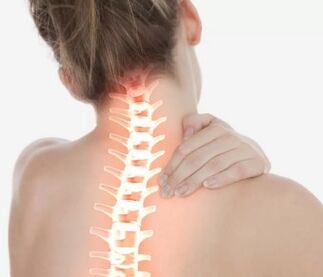Often the head hurts, dizziness - we think it is either a migraine or "for the weather."Pinched in the heart?Miner.Tingling or numbness in your hands - you need to sit at the computer less, move more.But the cause of these, at first glance, not related symptoms can be your spine.More precisely, its highest section is the cervical.
Neck.What do we know?

The cervical spine is the most mobile, vulnerable part of the spine, which allows you to perform tilting and turns of the head.It consists of 7 vertebrae, between which there are elastic intervertebral discs. They pass blood vessels that “nourish” the brain and supply it with oxygen.Nervous endings associated with the spinal cord (the inside of the spine) give impulses and signals to other organs of the body.As a result, the body works harmoniously.If the vertebrates due to metabolic disorders are deformed, they can squeeze the nerve endings or a blood vessel, a person experiences pain.It is the pain that is the main symptoms of such a disease as osteochondrosis of the cervical spine.
What is dangerous cervical osteochondrosis
- osteochondrosis of the cervical region is considered one of the most insidious diseases.Due to the fact that the cervical vertebrae are very close to each other, with the slightest deformation, the nerve roots and blood vessels are squeezed.Brain blood supply is disturbed.As a result - headache, up to migraines.With a neglected form, ischemia of the brain or spinal cord, even a stroke.
- The cardiovascular system can also be at risk.Increased or reduced pressure, pain in the heart is not always cardiological pathology.You can “knock down” the pressure for years, to be observed by a cardiologist, and the cause of such heart ailments can become cervical osteochondrosis.
- Due to compression of the nerve endings, hearing, vision and even coordination of movements can suffer.
Symptoms of neck osteochondrosis:
- pain.This can be a slight pain in the neck, especially when turning or after sleep.With cervical osteochondrosis, pain can be “given” at the occipital hour and shoulders.When the head is tilted forward, pain under the spatula can also occur.Headaches and migraines are also not rare in this disease.
- Numbness.Unpleasant sensations, tingling or numbness in the arm, shoulder, shoulder blades, neck.Cryst in the neck when turning your head.
- Noise and ringing in the ears.It is possible to worsen hearing.
- Nausea, lack of air. There is difficulty in breathing, it is impossible to breathe deeply, which leads to oxygen starvation of the body.
- Veasure of visual acuity, clouding, “flies” before the eyes.
- The instability of arterial pressure. Overwhelmed or reduced pressure.Dizziness.
An interesting fact. More than 80% of the population complain of neck pain, and 30% of headaches are associated with cervical osteochondrosis.
The causes of cervical osteochondrosis
osteochondrosis, in particular, osteochondrosis of the neck, is young today.We move less - we create more problems for the spine.If older people have come up with this problem earlier, today today a 20-30-year-old patient who complains about back pain and neck, you will not surprise the doctor.
The most common reasons:
- Sitting lifestyle
- insufficient physical activity
- Excess weight, metabolic disorders
- bad habits: alcohol consumption, smoking
- improper sleep: incorrectly selected pillow and mattress
- neck loads associated with a long -term forced position of the body
- injury
than treating cervical osteochondrosis, it is easy to confuse with banal osteochondrosisA common or fatigue: heaviness in the back of the head, headache, discomfort when turning the neck.Symptoms that many complain about, but not much suspect a true diagnosis - osteochondrosis of the cervical region.But the insidious disease: it progresses easily, and in advanced cases the treatment is long and expensive.
The symptoms of the disease are directly associated either with the infringement of the roots of the spinal cord, or with the squeezing of blood vessels or spinal cord.First of all, you need to contact a specialist, not self -medication. For the correct diagnosis, the doctor can prescribe additional research methods, including radiography, MRI, CT.
In the early stages, manual therapy, therapeutic gymnastics will be enough.This is the so -called, gentle therapy.
Injections, the prescription of drugs
In the inflammatory process, mediators (substances that are formed in large quantities in the focus of inflammation) can damage the nerve fibers, causing discomfort, as well as pain in the neck.In complex therapy, it is important not only to remove the pain syndrome, the inflammatory process, but also to create conditions for the regeneration of damaged tissues, including nervous ones.To launch these processes, preparations with group B vitamins are used - vitamins B1 - improve nervous tissue nutrition, restore their normal sensitivity, vitamin B6 improves the functioning of the nervous system as a whole, has a general strengthening effect.There is a water-soluble and fat-spontaneous form of vitamin B1.The effect of Benfotiamine (fat-and-disabled) is 5-10 times higher than thiamine (water-soluble).Due to the analgesic effect, these vitamins are called "new analgesics."In the treatment of osteochondrosis, doctors can recommend group B vitamins both in the form of injections and in the form of tablets.
When detected in the cervical scales, proprusion will have to resort to surgical intervention.What is important?After the main course of treatment, care for your spine is a task No. 1. Proper physical activity, nutrition, gymnastics should be constant your companions.























